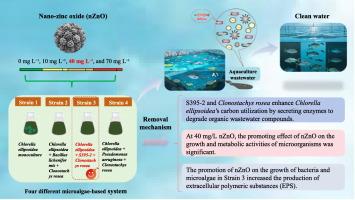纳米氧化锌浓度对微藻-细菌-真菌联合系统处理水产养殖废水去除营养物和抗生素性能的影响
IF 4.5
2区 生物学
Q1 BIOTECHNOLOGY & APPLIED MICROBIOLOGY
Algal Research-Biomass Biofuels and Bioproducts
Pub Date : 2025-07-30
DOI:10.1016/j.algal.2025.104247
引用次数: 0
摘要
在全球水产养殖业蓬勃发展的背景下,含有营养物质和抗生素残留的水产养殖废水的排放导致了严重的环境问题。本研究探讨了纳米氧化锌(nZnO)浓度对微藻-细菌-真菌联合系统中营养物和抗生素去除性能的影响。建立了四种不同的藻类处理技术体系。结果表明,菌株3(椭球小球藻+ S395-2 +蔷花小球藻)的生长性能最好。40 mg/L的nZnO浓度最有利于菌落的生长,提高了光合性能,促进了COD、TN和TP等营养物质的去除。在该浓度下,菌株3对COD(88.52±8.19%)、TN(86.44±8.05%)和TP(86.51±8.25%)的去除率最高。对于抗生素的去除,40 mg/L的nZnO浓度为最佳。菌株3对各种抗生素的去除率最高。菌株3在40 mg/L nZnO作用下对四环素(TC)和土霉素(OTC)的去除率分别为99.08±0.62%和96.45±2.63%。其去除机制包括微藻、细菌和真菌之间的协同作用,以及nZnO对微生物代谢活性的影响。本研究提出的优化共生系统和nZnO浓度调节策略,既能有效处理水产养殖废水,又能通过微生物的天然代谢减少化学物质的使用,为废水修复提供了一种经济、环保的可持续解决方案。本文章由计算机程序翻译,如有差异,请以英文原文为准。

Effect of nano-zinc oxide concentration on nutrient and antibiotics removal performance by microalgae-bacteria-fungi consortia system treating aquaculture wastewater
In the context of the booming global aquaculture industry, the discharge of aquaculture wastewater containing nutrients and antibiotic residues has led to serious environmental problems. This study explored the effect of nano-zinc oxide (nZnO) concentration on the nutrient and antibiotics removal performance of microalgae-bacteria-fungi consortia systems. Four different algae treatment technology systems were established. The results showed that Strain 3 (Chlorella ellipsoidea + S395–2 + Clonostachys rosea) had the best performance. A concentration of 40 mg/L nZnO was most beneficial for the growth of the consortia, enhancing photosynthetic performance and promoting the removal of nutrients such as COD, TN, and TP. The growth rates of all strains reached the maximum, and Strain 3 had the highest removal efficiencies of COD (88.52 ± 8.19 %), TN (86.44 ± 8.05 %), and TP (86.51 ± 8.25 %) among the four strains under this concentration. For antibiotics removal, a 40 mg/L nZnO concentration was optimal. Strain 3 showed the highest removal rates for various antibiotics. The removal rates of tetracycline (TC) and oxytetracycline (OTC) by Strain 3 at 40 mg/L nZnO reached 99.08 ± 0.62 % and 96.45 ± 2.63 % respectively. The removal mechanisms involved the synergistic effects among microalgae, bacteria, and fungi, as well as the influence of nZnO on the metabolic activities of microorganisms. The optimized symbiotic system and nZnO concentration regulation strategy proposed in this study not only efficiently treat aquaculture wastewater but also reduce chemical usage through natural microbial metabolism, providing a cost-effective and eco-friendly sustainable solution for wastewater remediation.
求助全文
通过发布文献求助,成功后即可免费获取论文全文。
去求助
来源期刊

Algal Research-Biomass Biofuels and Bioproducts
BIOTECHNOLOGY & APPLIED MICROBIOLOGY-
CiteScore
9.40
自引率
7.80%
发文量
332
期刊介绍:
Algal Research is an international phycology journal covering all areas of emerging technologies in algae biology, biomass production, cultivation, harvesting, extraction, bioproducts, biorefinery, engineering, and econometrics. Algae is defined to include cyanobacteria, microalgae, and protists and symbionts of interest in biotechnology. The journal publishes original research and reviews for the following scope: algal biology, including but not exclusive to: phylogeny, biodiversity, molecular traits, metabolic regulation, and genetic engineering, algal cultivation, e.g. phototrophic systems, heterotrophic systems, and mixotrophic systems, algal harvesting and extraction systems, biotechnology to convert algal biomass and components into biofuels and bioproducts, e.g., nutraceuticals, pharmaceuticals, animal feed, plastics, etc. algal products and their economic assessment
 求助内容:
求助内容: 应助结果提醒方式:
应助结果提醒方式:


